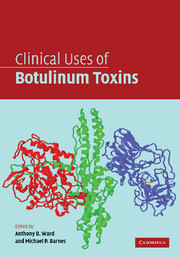Book contents
- Frontmatter
- Contents
- List of Contributors
- 1 Introduction
- 2 Mechanistic basis for the therapeutic effectiveness of botulinum toxin A on over-active cholinergic nerves
- 3 Botulinum toxin: from menace to medicine
- 4 Botulinum toxin: primary and secondary resistance
- 5 Introduction to botulinum toxin in clinical practice
- 6 Cervical dystonia
- 7 The use of botulinum toxin in otolaryngology
- 8 Spasticity
- 9 Hyperhidrosis
- 10 Hypersalivation
- 11 Botulinum toxin type A for the prophylactic treatment of primary headache disorders
- 12 Botulinum toxin in the management of back and neck pain
- 13 Clinical uses of botulinum toxin
- 14 Bladder and bowel indications
- 15 Cosmetic uses of botulinum toxin A
- 16 Other clinical neurological uses of botulinum toxin
- Index
- Plate section
- References
16 - Other clinical neurological uses of botulinum toxin
Published online by Cambridge University Press: 02 December 2009
- Frontmatter
- Contents
- List of Contributors
- 1 Introduction
- 2 Mechanistic basis for the therapeutic effectiveness of botulinum toxin A on over-active cholinergic nerves
- 3 Botulinum toxin: from menace to medicine
- 4 Botulinum toxin: primary and secondary resistance
- 5 Introduction to botulinum toxin in clinical practice
- 6 Cervical dystonia
- 7 The use of botulinum toxin in otolaryngology
- 8 Spasticity
- 9 Hyperhidrosis
- 10 Hypersalivation
- 11 Botulinum toxin type A for the prophylactic treatment of primary headache disorders
- 12 Botulinum toxin in the management of back and neck pain
- 13 Clinical uses of botulinum toxin
- 14 Bladder and bowel indications
- 15 Cosmetic uses of botulinum toxin A
- 16 Other clinical neurological uses of botulinum toxin
- Index
- Plate section
- References
Summary
Introduction
This chapter will highlight some of the less common but nevertheless helpful uses of botulinum toxin for a variety of neurological conditions. The list of potential uses of botulinum toxin is growing each year and this chapter does not attempt to offer a completely comprehensive guide to every case report in every potential neurological condition. This chapter discusses the reasonably established use in the following conditions:
Tics
Myoclonus
Stiff person syndrome
Parkinson's disease
Tremor
Limb dystonia including occupational cramps
Each section will give a brief overview of the condition itself and then give some thoughts with regard to the place of botulinum toxin in the treatment of the condition. None of these conditions yet constitute a licensed indication for botulinum toxin type A or type B. Indeed the conditions and indications are so rare that it is unlikely that definitive trials will be undertaken in order to satisfy the licensing regulations. However, the lack of a license indication can still mean that botulinum toxin may be a useful addition to our therapeutic armoury in these conditions, which are often difficult to ameliorate.
Tics
Background
A tic is a sudden rapid recurrent non-rhythmic stereotyped motor movement or vocalization. Tourette's syndrome is characterized by both multiple motor and vocal tics. Tics are extremely common in childhood and some studies indicate a prevalence of up to a quarter of all children being affected at some point during their childhood.
- Type
- Chapter
- Information
- Clinical Uses of Botulinum Toxins , pp. 349 - 374Publisher: Cambridge University PressPrint publication year: 2007

